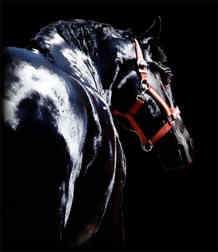
1. Chronic Obstructive Pulmonary Disease (COPD)
Chronic obstructive pulmonary disease is "An allergic lung disease in horses resulting in obstruction of the lower airways due to bronchoconstriction, mucus accumulation and inflammation" (Derksen 1991) and is one of the most common respiratory diseases affecting the horse. The horse has severely dyspenic signs with flaring nostrils and marked abdominal effort on expiration. The horse is in distress and there is little chance of it performing well or at all. The manifestations of the disease are associated with bronchospasm, mucosal inflammation and mucous plugging.
It is one of the most common problems that hinder the horse’s ability to breathe. It causes loss of performance (Persson and Linderberg 1991, Macnamara et al 1990), chronic coughing and discharge from the nostrils. The horse’s lungs lose elasticity, the air passages become more constricted and breathing becomes forced. When exercising, the horse has to breathe harder and the effort makes him cough. When asked, "if a horse is coughing, has it got lower airway disease", Robinson (1998) replied "Oh yes".
Allergic sensitivity to hay dust, moulds, pollen and bacteria can precipitate COPD and can be described as being similar to asthma in humans. Fungus spores may invade the air passages and live on mucus produced by the membranes causing the spores to become a constant irritant. Acute episodes can occur if the horse comes into contact with something to which he is sensitive; e. g. eating dusty feed can trigger coughing spasms. COPD can also be a precursor to viral or bacterial infection.
COPD is characterised by inflammation of the distal airways (Derksen 1987), bronchospasm, peribronchial infiltration and plugging of the airway lumens by mucus and cellular exudate causing lower airway obstruction (Beech 1991). Inflammation of the lower airway is as a result from inhaling environmental dust, hypersensitivity to inhaled antigens and non-specific hyper-responsiveness and they have all been implicated in pathogenesis (McPherson and Thompson 1983, Dersen et al 1985, Doucet et al 1991, Buechner-Maxwell 1993, Halliwell et al 1993, McGorum et al 1993).
2. Reference to stabling
COPD-susceptible horses get airway inflammation as a result of being stabled because of the dusty conditions in a small area. Horses that have a cough are very likely to have had a lower airway disease for more than one month (Burrell et al 1996). Horses housed on straw in loose boxes are twice as likely to suffer from lower airway disease than those kept on shredded paper in American barns (Burrell et al 1996). Ventilation, in conjunction with care in feed quality and other hygiene considerations, is of prime importance in controlling the air quality and limiting the incidence of respiratory diseases (Krawiecki 1995). Effective management involves removal of all aetiological agents from the horse’s environment.
Vandenput et al (1998) conducted a study to see what condition horses with COPD in clinical remission could be kept in. Proper management of the environment to minimise exposure to dusty air is still the most important element of treatment (Thompson and McPherson 1983). A horse with COPD is best at pasture as is has been removed from the dusty environment (Robinson 1998). It may take weeks for the inflammation to disappear and, if put back into the environment that contained the antigens, the horse will immediately relapse.
3. Other diseases
Stress is a factor in other respiratory diseases like Equine Influenza and Equine Herpes Virus (EHV) disease. Equine Influenza is a viral infection that can be brought on through crowded stabling, poor ventilation and stress. EHV 1 is a fungal infection and also requires well-ventilated and clean environment.
The diseases relating to stereotypies have been mentioned chapter No. 6 (pp 35), but the implications of box walking have not. It causes not only fatigue but those horses who only go in one direction have excessive build up of muscles on one side of the body and muscle wastage on the other.